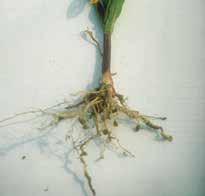chAPter 15 Preventing and lessening CoMPaCtion
Table 15.1
Types of Compaction and Their Remedies
Compaction Type
Indications
Remedies/Prevention
Breakdown of surface aggregates
Reduce tillage intensity.
and sealing of surface
Leave residues on surface.
Surface crusting
Poor seedling emergence
Add organic matter.
Accelerated runoff and erosion
Grow cover crops.
Plow with moldboard or chisel plow,
but reduce secondary tillage.
Do primary tillage before winter
(if no erosion danger exists).
Deep wheel tracks
Use zone builders.
Prolonged saturation or standing water
Increase organic matter additions.
Plow layer
Poor root growth
Use cover crops or rotation crops
Hard to dig and resistant to penetrometer
that can break up compact soils.
Cloddy after tillage
Use better load distribution.
Use controlled traffic.
Don’t travel on soils that are wet.
Improve soil drainage.
Don’t travel on soils that are wet.
Improve soil drainage.
Till deeply with a subsoiler or zone builder.
Roots can’t penetrate subsoil
Subsoil
Use cover crops or rotation crops
Resistant to penetrometer at greater depths
that penetrate compact subsoils.
Use better load distribution.
Use controlled traffic.
Don’t use wheels in open furrows.
The impact of surface crusting is most damaging
Reducing Surface Crusting
when heavy rains occur between planting and seedling
Crusting is a symptom of the breakdown of soil structure
emergence. The hard surface crust may delay seedling
that develops especially with intensively and clean-tilled
emergence and growth until the crust mellows with the
soils. As a short-term solution, farmers sometimes use
next rains. If such follow-up showers do not occur, the
tools such as rotary hoes to break up the crust. The best
crop may be set back considerably. Crusting and sealing
long-term approach is to reduce tillage intensity, use
of the soil surface also reduce water infiltration capacity.
tillage and cover cropping systems that leave residue or
This reduction in infiltration increases runoff and ero-
mulch on the surface, and improve aggregate stabil-
sion and lessens the amount of available water for crops.
ity with organic matter additions. Even residue covers
as low as 30% will greatly reduce crusting and provide
important pathways for water entry. A good heavy-duty
162
Building SoilS for Better CropS: SuStainaBle Soil ManageMent







